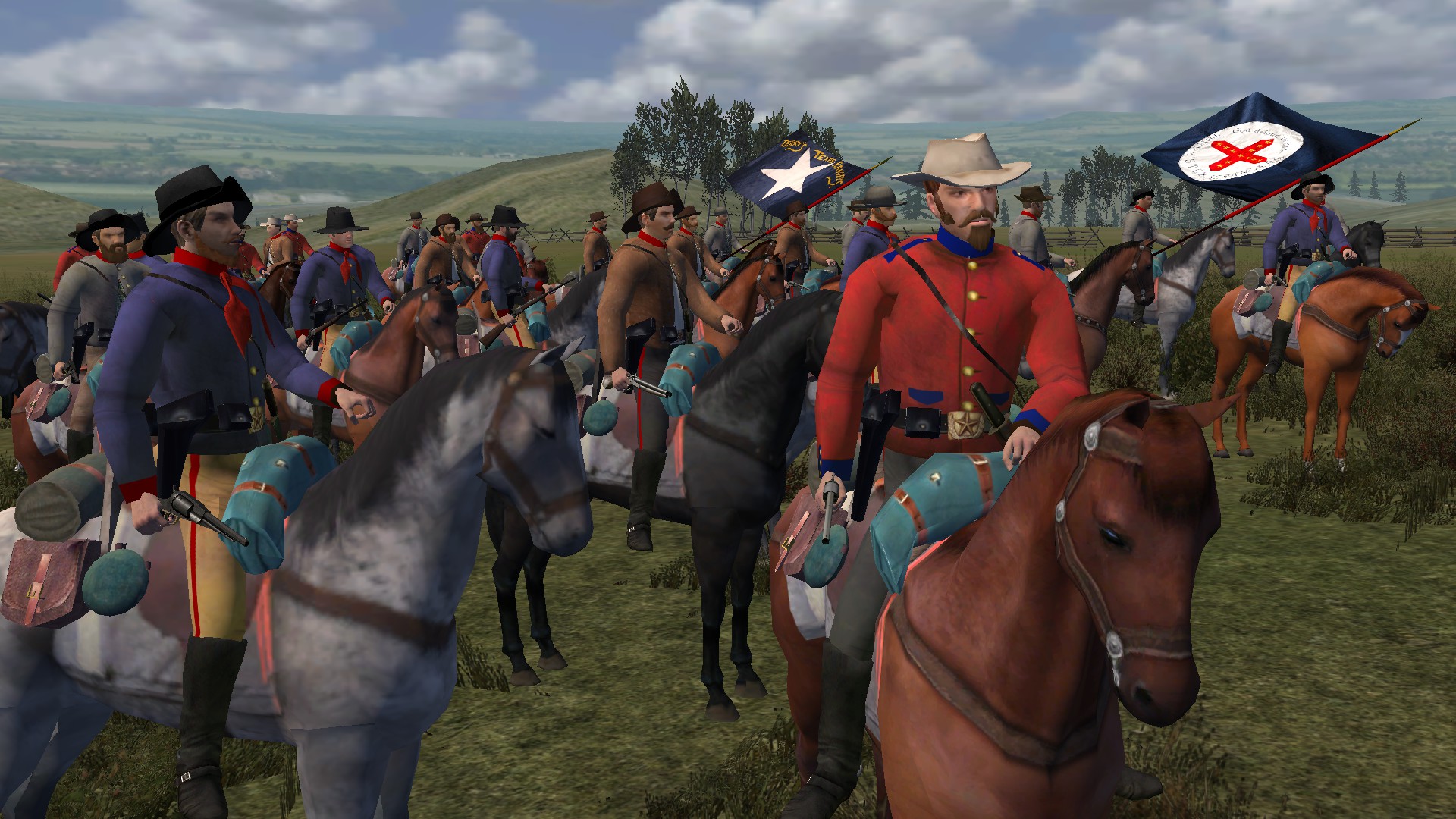Confederate Cavalry Guide
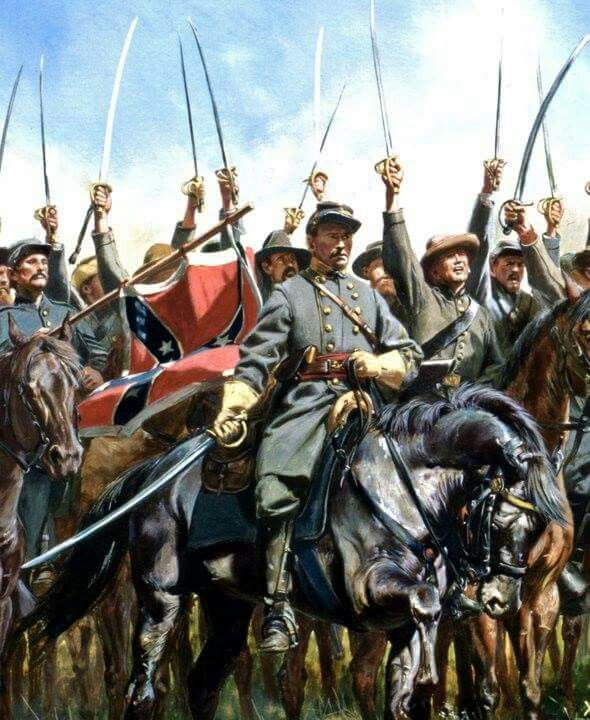
The following is a comprehensive list of all cavalry and mounted infantry units in the mod that are currently available to the Confederacy. This guide is intended to not only show what units are available, but to also give players a quick reference to where those units can be recruited from in the mod, the weapons they are equipped with, as well as which faction and generals they are currently assigned to.
This guide is organized according to the type of unit, their home state (in alphabetical order), and their designated number (if applicable).
Florida
2nd Florida Cavalry
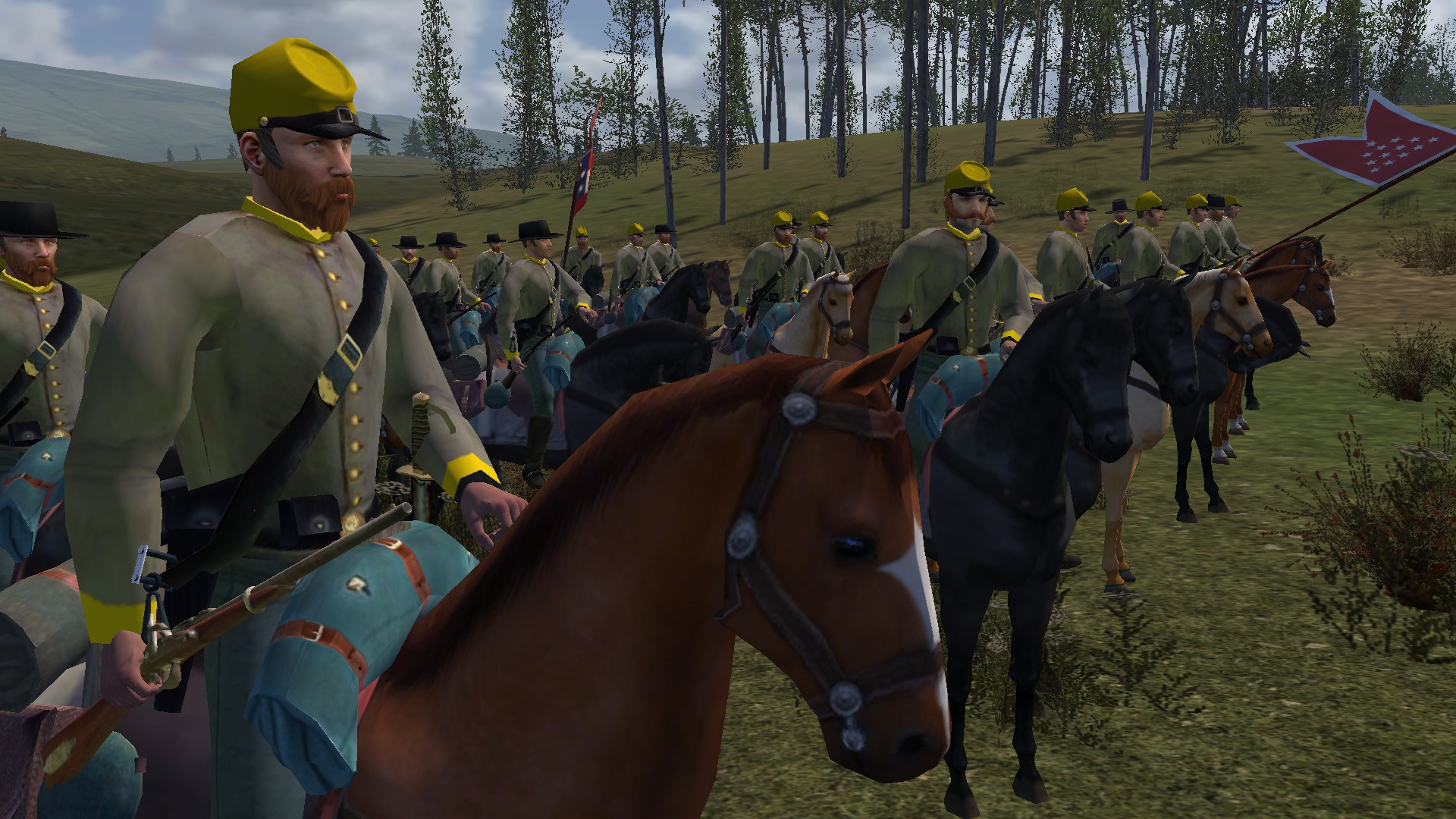
Weapons: M1859 Sharps Carbine, Maynard Carbine, Pattern 1861 Enfield Musketoon, Merrill Carbine, Sabers
Faction: Army of Tennessee
Current Commander: Major General Joseph Wheeler
Recruitment Locations: St. Augustine, Tallahassee, Pensacola, Fort Stonewall, Fort Ward, Fort Pickens, Fort Marion, Navarre, Brunswick, Tampa, St. Marks, Madison, Selma, Olustee, Gainesville, Jacksonville, Troy, Starkville
The 2nd Florida Cavalry was organized at Jacksonville, Florida, in July 1863, initially under the command of Colonel George Troup Maxwell, and later in the war by Colonel Robert Harrison Anderson Jr. The 2nd Florida saw action in several significant battles, including the Battle of Olustee, which was the largest battle fought in Florida in the Civil War. They also participated in battles in Virginia, Georgia, and Alabama. The regiment was known for their effective use of guerilla tactics and their swift movements.
Due to the nature of their combat style, the regiment often operated independently without the support of a larger force. The 2nd Florida Cavalry engaged in numerous skirmishes and raids behind Union lines, disrupting supply lines and communications, as well as delaying the arrival of Union reinforcements at critical times. At the end of the war, the surviving members of the 2nd Florida cavalry were paroled and returned to their homes.
Georgia
Cobb's Legion Cavalry

Weapons: M1859 Sharps Carbine, Maynard Carbine, Sabers
Faction: Army of Northern Virginia
Current Commander: Brigadier General William N. Pendleton
Recruitment Locations: Atlanta, Savannah, Fort Wagner, Calhoun, Augusta, Macon, Murphy, Athens, Cedar Shoals
Cobb's Legion was organized by Thomas Reade Rootes Cobb in the State of Georgia during the summer of 1861. The legion was composed of cavalry, infantry, and artillery, but did not serve as one command. The artillery company was an independent unit known as the Troup Light Artillery and its history is given under that name. The concept of a multiple-branch unit was fine in theory, but never was a practical application for Civil War armies and, early in the war, the individual elements were assigned to other organizations.
The cavalry battalion included men from Richmond, Fulton, and Dougherty counties and contained six companies. Later five more were added and the unit served with eleven companies until July, 1864. At that time, one company transferred to Phillips' Georgia Legion, bringing the battalion's strength to a total of 526 officers and men. Its designation was also changed to the 9th Georgia Cavalry, but was rarely used. The unit was assigned to General Hampton's, Butler's, and P.M.B. Young's Brigade, and participated in many large engagements, from the Seven Days' Battles to Cold Harbor.
The cavalry battalion was later involved in numerous battles south and north of the James River. At Brandy Station, the battalion lost 3 officers and 41 enlisted men, and sustained 21 casualties out of the 330 engaged at Gettysburg. In 1865, it was attached to T.M. Logan's Brigade, fought in the Carolinas, and then finally surrendered with the Army of Tennessee at Greensboro, North Carolina, on April 26th, 1865.
Indian Territory
1st Cherokee Mounted Rifles
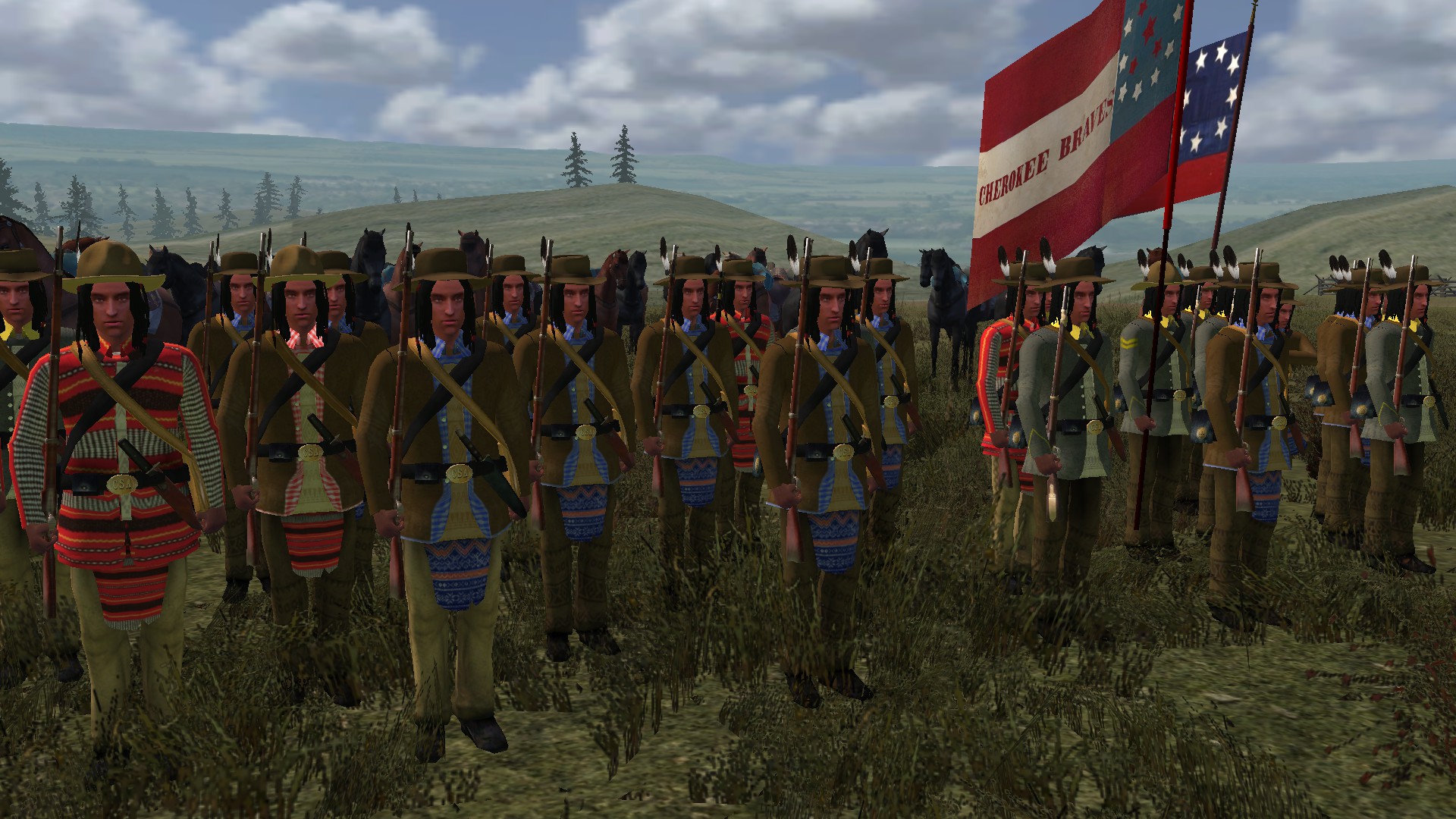
Weapons: M1841 Mississippi Rifle, Springfield Model 1861 Rifle Musket, Pattern 1856 Enfield "Short Rifle"
Faction: Army of Tennessee
Current Commander: Major General Carter L. Stevenson
Recruitment Locations: Houston, Corinth, Memphis, Little Rock, Greenville, Paducah, Pea Ridge, Corpus Christi, Tupelo
In July 1861, Confederate officials commissioned Stand Watie as a colonel in the Confederate States Army and authorized him to raise the Cherokee Mounted Volunteers. After Cherokee Principal Chief John Ross signed the Cherokee-Confederate treaty of alliance in October 1861, he and the Cherokee Council authorized and raised the First Regiment of Cherokee Mounted Rifles, commanded by Colonel John Drew. The regimental officers and men under Drew's command were largely full-blooded Cherokees, who were ideologically uncommitted to the goals of the Confederacy, but were loyal to Chief John Ross. Watie's regiment became the Second Regiment of Cherokee Mounted Rifles, and Watie's regiment consisted largely of Cherokees of mixed blood (Métis) who, as slaveholders, favored the Confederate cause.
Drew's regiment became part of Colonel Cooper's command and was ordered to help stop the retreat of Union supporting Creeks, led by their principal chief Opothleyahola, who were attempting to flee to Kansas. Although the unit participated in the Battle of Round Mountain, the Battle of Chusto-Talasah, and the Battle of Chustenahlah, they made known their dislike for fighting the Creeks, who had done the Cherokees no harm. A portion of Drew's regiment deserted in late 1861. Following the Battle of Old Fort Wayne in October 1862, most of the remainder of Drew's men, including Major Thomas Pegg, deserted to the Union army. What remained of his troops was combined with Watie's regiment and reorganized as the First Regiment of Cherokee Mounted Rifles with Watie in command.
During the Civil War, Watie's troops participated in 27 major engagements and numerous smaller skirmishes. Although some of the engagements were major battles, most of their activities utilized guerrilla tactics. From south of the Canadian River, Watie's men launched raids throughout northern-held Indian Territory and into Kansas and Missouri, tying down thousands of Union troops. Poorly equipped and armed mostly with castoff rifles or captured weapons, the Cherokees were well suited to this type of warfare. In May 1864, Watie was promoted to brigadier general. Watie's greatest victories included the Ambush of the steamboat J. R. Williams, in June 1864, and the capture of a Union wagon train at the Second Battle of Cabin Creek in September 1864. Watie is infamous for the burning of Rose Cottage, the home of Chief John Ross, as well as the burning of the Cherokee Council House in October 1863. At the Hay Camp Action (a.k.a. the Battle of Flat Rock) in September 1864, Watie and his men ambushed and massacred detachments of the First Kansas Colored Infantry and 2nd Regiment Kansas Volunteer Cavalry.
In February 1865, Watie was given command of the Indian Division of Indian Territory but was unable to launch any offensive operations. He disbanded most of his troops following the collapse of Confederate resistance in the spring of 1865. After participating in the Camp Napoleon Council in May, Stand Watie officially surrendered on June 23rd, 1865, dissolving his regiment and becoming the last Confederate general to lay down his arms.
South Carolina
Hampton's Legion Cavalry Battalion
Weapons: M1859 Sharps Carbine, Maynard Carbine, Sabers
Faction: Army of Northern Virginia
Current Commander: Lieutenant General Wade Hampton
Recruitment Locations: Charleston, Raleigh, Knoxville, Salem, Fort Macon, Fort Fisher, Charlotte, New Bern, Camden, Wilmington, Fayetteville, Winston-Salem, Newport, Hillsborough, Kingstown, Columbia, Sandy Springs, Roanoke Rapids
Organized and partially financed by wealthy South Carolina planter Wade Hampton III in the summer of 1861, Hampton's Legion was initially composed of six companies of infantry, two of cavalry, and one of light artillery, with elements of Hampton's Legion participating in virtually every major campaign in the Eastern Theater, from the first battle to the last. Hampton had no military experience at all, but had a natural ability that made him an outstanding leader and one of the best Confederate generals in the war. Hampton financed all of the Legion's weapons himself, and the unit had some of the finest uniforms among all of the early war volunteers. A legion historically consisted of a single integrated command, with individual components including infantry, cavalry, and artillery. The concept of a multiple-branch unit was never a practical application for armies in the American Civil War and, early in the war, the individual elements were assigned to other organizations. Hampton's Legion initially boasted a large number of South Carolina's leading citizens, including future generals J. Johnston Pettigrew, Stephen Dill Lee, Martin W. Gary, and Matthew C. Butler.
The cavalry battalion fought in the Seven Days' Battles, and with the reorganization of the Army of Northern Virginia in mid-1862, Hampton's Legion was broken up and reassigned. The cavalry battalion was consolidated with the 4th South Carolina Cavalry Battalion and two independent companies, and became the 2nd South Carolina Cavalry, under Colonel Butler. It remained directly under General Hampton's control and served in his brigade and then division for the rest of the war. In May, 1864, the infantry component of Hampton's Legion was reorganized, mounted, and united with the 2nd South Carolina Cavalry.
The cavalry regiment lost 37% of the 350 men engaged at the Battle of Seven Pines in April, 1862, and sustained 20 casualties at Gaines' Mill, 74 at Second Manassas, 53 in the Maryland Campaign, and 85 at Wauhatchie. During the lengthy Siege of Petersburg, they harassed Federal supply depots throughout northern Virginia and fought in several actions. The South Carolina cavalry regiment went on to participate in the Carolinas Campaign with General Hampton, before surrendering at Bennett Place in North Carolina, along with the rest of General Joseph E. Johnston's forces on April 26th.
Tennessee
Forrest's Cavalry Corps
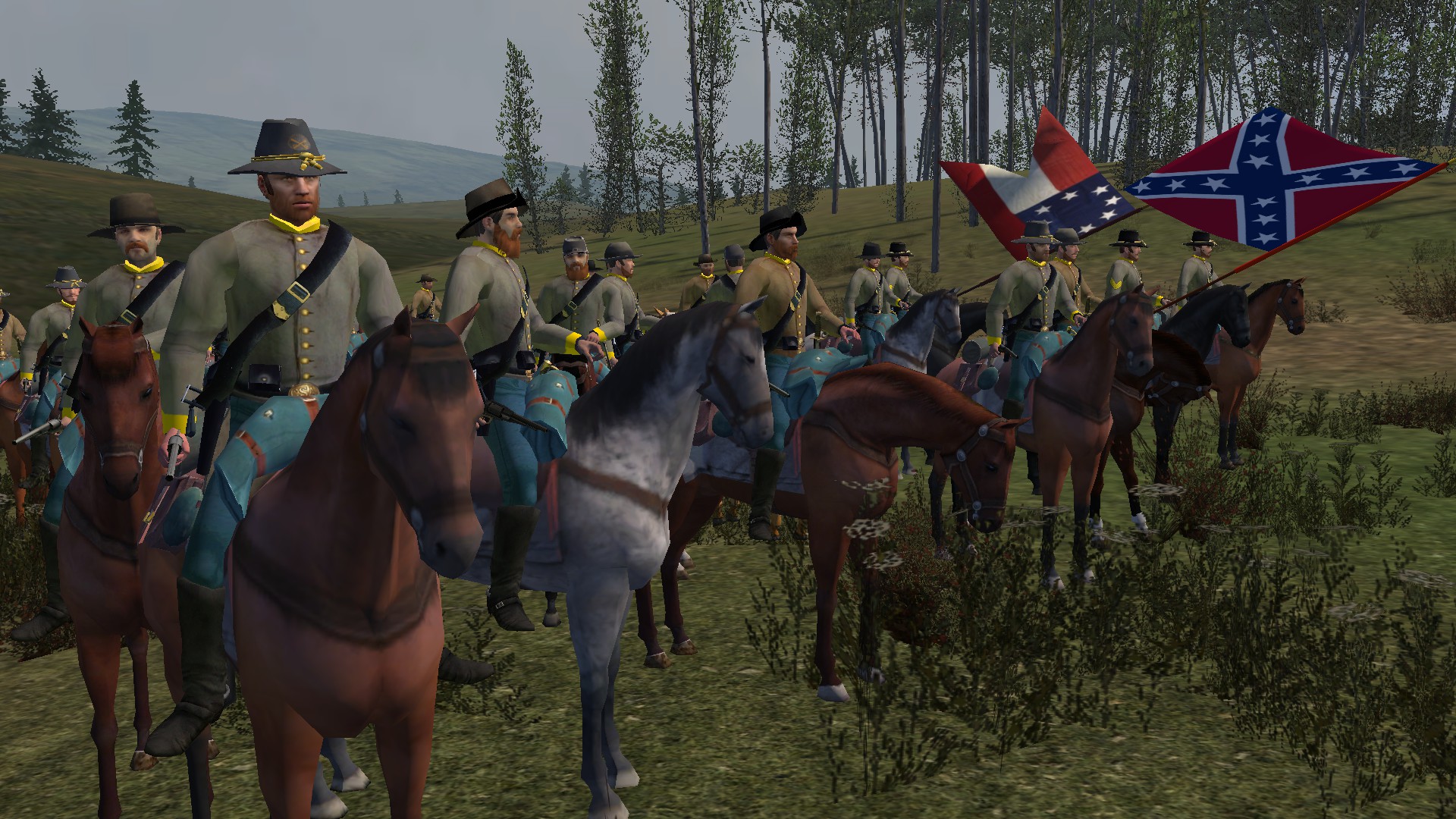
Weapons: M1859 Sharps Carbine, Maynard Carbine, Merrill Carbine, Revolvers, Sawed-Off Shotguns, Sabers
Faction: Army of Tennessee
Current Commander: Brigadier General Nathan Bedford Forrest
Recruitment Locations: Montgomery, Nashville, Fort Defiance, Chattanooga, Hopkinsville, Oxford, Munford, Franklin, Clarksville, Murfreesboro, Birmingham, Johnsonville, Talladega
Organized as an eight-company battalion at Memphis, Tennessee, in October, 1861, it was increased to regimental size in January, 1862. The history of this unit is very complex because over twenty companies from Tennessee, Kentucky, Texas, Mississippi, and Louisiana were attached to it at one time or another. In May 1863, Nathan Bedford Forrest was given the cavalry command of Earl Van Dorn, who had recently been murdered. On September 3rd, Braxton Bragg, commander of the Army of Tennessee, gave Forrest the division of John Pegram and placed him in command of all the cavalry north of Chattanooga.
During the early stages of the Chickamauga Campaign, Forrest's corps served on the army's right as a rear guard during the retreat from Chattanooga, while Forrest himself was wounded during the fighting. The corps covered the right flank of D. H. Hill's corps during the Battle of Chickamauga, earning praise from Hill:
"General Forrest, I wish to congratulate you and those brave men moving across that field like veteran infantry upon their magnificent behavior... No one can speak disparagingly of such troops as yours."
The first test of Forrest's new cavalry corps began with General Sherman's Meridian Expedition. At Battle of Okolona on February 22nd, General Forrest moved his cavalry into position and struck the Union cavalry from three directions. This was a minor victory but it was good practice for more raids out of Memphis by Union cavalry. On March 16th, Forrest launched another raid into western Tennessee to capture Union supplies for his corps and to allow his Kentucky and Tennessee troops to return home. Forrest established his headquarters at Jackson and from there, he moved his brigades to attack Union installations. Infamously, at the Battle of Fort Pillow on March 24th, soldiers commanded by Forrest massacred Union troops, many of them African-Americans of the USCT, who were attempting to surrender.
U.S. Army survivors said that even though all their troops surrendered, Forrest's men massacred some in cold blood. Surviving members of the garrison said that most of their men surrendered and threw down their arms, only to be shot or bayoneted by the attackers, who repeatedly shouted, "No quarter! No quarter!" The Joint Committee On the Conduct of the War immediately investigated the incident, which was widely publicized in the U.S. press. In their report, they concluded that the Confederates shot most of the garrison after it had surrendered.
On their part, Forrest's men insisted that the U.S. soldiers, although fleeing, kept their weapons and frequently turned to shoot, forcing the Confederates to keep firing in self-defense. Their claim is consistent with the discovery of numerous U.S. Army rifles on the bluffs near the river, and the U.S. flag was still flying over the fort, which indicated that the force had not formally surrendered. A contemporary newspaper account from Jackson, Tennessee, states that "General Forrest begged them to surrender", but "not the first sign of surrender was ever given". Similar accounts were reported in both Southern and Northern newspapers at the time.
A 2002 study by Albert Castel concluded that Forrest's troops had killed a large number of the garrison "after they had either ceased resisting or were incapable of resistance". Historian Andrew Ward in 2005 concluded that an atrocity in the modern sense occurred at Fort Pillow, but that the event was not premeditated nor officially sanctioned by Confederate commanders.
In June, both Forrest and the corps were transferred to northern Mississippi and often launched independent raids into Union occupied western and central Tennessee. Forrest was then ordered to move into northern Alabama to unite with the Army of Tennessee, now commanded by John B. Hood, and participated in his invasion of central Tennessee. After Hood's campaign ended in failure, Forrest regrouped his corps in northern Mississippi, where he attempted to replenish his equipment and recruit additional men, even offering a twenty-day furlough to any man who brought in a new recruit. In January, Richard Taylor named Forrest commander of all cavalry units in the Department of Alabama, Mississippi, and East Louisiana; Forrest reorganized his forces into four divisions split along state lines, commanded by Chalmers, Buford, Jackson, and Tyree Bell.
Union diversions staged throughout the early months of 1865 forced Forrest to disperse his men across a wide region. In late March, Union Major General James H. Wilson started a massive raid through Alabama, with the intention of destroying Confederate industrial centers, especially the factories located at Selma, Alabama. Forrest attempted to delay Wilson near Plantersville on April 1st in order to gain time for his scattered force to concentrate but Wilson overran the Confederate positions, taking 300 prisoners and forcing Forrest to retreat into the defenses of Selma. Once in Selma, Forrest attempted to gather every man capable of fighting, including the local home guard and militia, into the city's defenses works but he had too few troops to adequately man the works. Wilson launched an attack in the late afternoon of April 2nd and quickly overran the defenses, capturing 2,700 men and 30 cannons while losing only 350 men himself. Over the next few weeks, Forrest attempted to gather and reorganize his corps, however when he received word that Taylor had surrendered his department, Forrest formally surrendered his command on May 9th.
Forrest remains a controversial figure in U.S. history for his involvement with the slave trade before the war, his role in the massacre at Fort Pillow, and his postwar leadership of the Ku Klux Klan. He is, however, still generally acknowledged by historians and scholars as a skilled cavalry leader and for his establishment of new doctrines for mobile forces, earning him the nickname "The Wizard of the Saddle". His usage of cavalry troops as mounted infantry, and often deploying artillery as the lead in battle, helped to revolutionize cavalry tactics, which formed the backbone of modern day mobile warfare doctrines.
Texas
Terry's Texas Rangers
Weapons: M1859 Sharps Carbine, Revolvers, Sawed-off Shotguns
Faction: Army of Pensacola
Current Commander: Brigadier General Raleigh E. Colston
Recruitment Locations: Jackson, Houston, Vicksburg, Shreveport, Alexandria LA, Blair's Landing, Port Hudson, Baton Rouge, Corpus Christi
The 8th Texas Cavalry Regiment, popularly known as Terry's Texas Rangers, was a light cavalry regiment of Texas volunteers assembled by Colonel Benjamin Franklin Terry in August 1861. Though lesser known than the Texas Brigade, the 8th Texas Cavalry distinguished itself at several battles during the American Civil War. In four years of service, Terry's Texas Rangers fought in about 275 engagements in seven states. The regiment earned a reputation that ranked it among the most effective mounted regiments in the Western Theater of the American Civil War.
The Texans' riding and shooting skills often caused them to be used as shock troops, and their first major action was at the Battle of Shiloh, where they distinguished themselves. The Rangers' ability in harassing the enemy was often called upon against William Tecumseh Sherman. Following the loss of Atlanta, the regiment harassed the flanks of Sherman's force as it marched through Georgia, although by then the Confederacy lacked the strength to stop him. Their last engagement was at the Battle of Bentonville, where they made their final charge, losing three of their officers: Colonel Gustave Cook, Lieutenant Colonel Christian, and Major Jarmon. Declining to surrender with the rest of the Army of Tennessee on April 26th, 1865, 158 of the reported 248 survivors of the regiment slipped through Union lines and made their way south in an effort to link up with other Confederates that had yet to surrender. With the total collapse of the Southern cause, however, the Rangers drifted home as individuals and in small groups, having never officially surrendered.
5th Texas Lancers
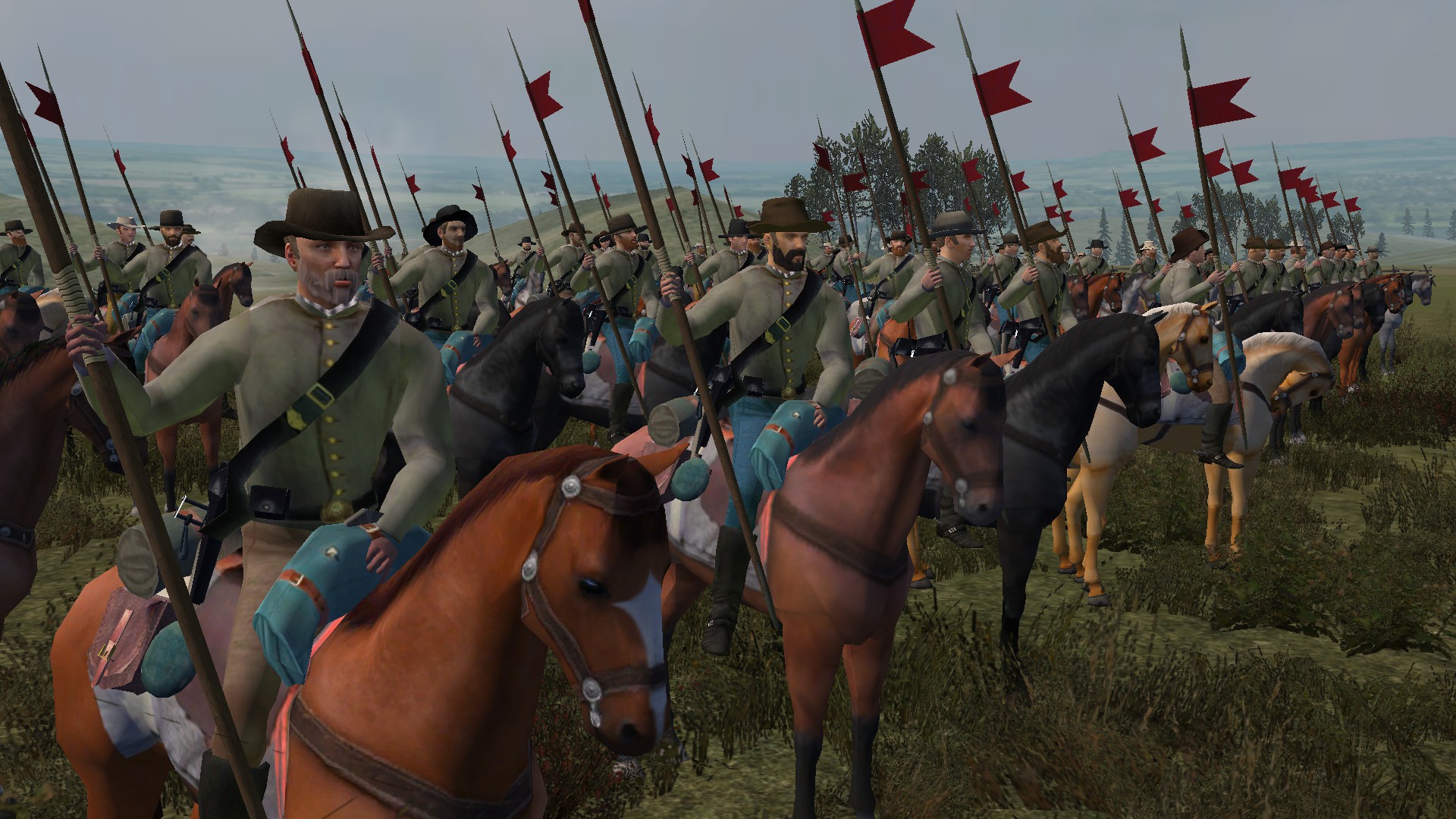
Weapons: Lances
Upgrades to: Revolvers, Sawed-off Shotguns, Sabers
Current Commander: Unassigned
Recruitment Locations: Houston, Shreveport, Blair's Landing, Corpus Christi
On August 12th, 1861, Confederate Brigadier General Henry H. Sibley arrived in San Antonio to organize a brigade for a campaign in New Mexico and Arizona. Three regiments of cavalry or mounted riflemen, each with an attached battery of howitzers, were quickly formed for service in what would come to be known as the Sibley's Brigade. The Fifth was recruited, for the most part, in Waco, San Antonio, Bonham, Weatherford, and Austin and was organized and mustered into Confederate service at San Antonio with 926 officers and men. The volunteers supplied their horses and their own weapons, the quality of which varied widely. The regiment was to be commanded by the famed Texas Ranger, Thomas Green, who accepted his commission as colonel on August 20, 1861.
Regarded as handsome and chivalrous heirs of medieval knights, the lancers were the darlings of the parade through San Antonio on the day the Army of New Mexico headed west. Bright red flags with white stars snapped from their lances. Lances had been common on Napoleonic battlefields, and were used by Mexican cavalry during the conflicts against the Texans in the 1830's and 1840's. The lances that these two companies carried were in fact war trophies captured from the Mexicans during the Mexican-American War, 13 years earlier.
The Fifth Texas Cavalry played a conspicuous role at the Battle of Valverde, with Captain Willis L. Lang, the commander of Company B, leading what was perhaps the only charge of lancers in the Civil War. Lang volunteered to charge what was assumed to be a company of inexperienced New Mexico Volunteers, who would break and run from a lancer charge. However they were actually Captain Theodore Dodd's Independent Company of Colorado Volunteers, who were a scrappy collection of miners and cowboys who were reputedly low on discipline but high on fighting spirit. They coolly waited until the lancers were within easy range, then fired a volley that unhorsed many of the riders. Their second volley finished the assault. More than half of Lang's men were either killed or wounded, and most of the horses lay dead on the field. Lang himself dragged himself back to the Confederate lines because he was too injured to walk.
The destruction of his company showed that modern firearms had rendered the ten-foot long weapons obsolete. McCown's men, and what remained of Lang's men, threw their lances into a heap and burned them. They then rearmed themselves with pistols and shotguns and returned to the fight. Lang and the rest of the injured Confederates were carried north to the town of Socorro, where they had requisitioned a house and turned it into a hospital. A few days later, depressed and in great pain, Lang asked his color sergeant for his revolver, with which he took his own life.
The regiment played a notable part in subsequent engagements of the New Mexico campaign, but after enduring a hideous march back to Texas when Sibley's campaign ended in failure, the 5th Texas returned to San Antonio with only 454 officers and men fit for duty. After a brief period in which the men rested and re-equipped themselves, the regiment was sent to the Texas Gulf Coast to take part in Major General John B. Magruder's recapture of Galveston on January 1st, 1863. From Galveston, the 5th Texas Cavalry, as a part of Green's brigade, was transferred to the Bayou Teche region of southern Louisiana to resist Major General Nathaniel P. Banks' attempted overland drive on Texas from the Mississippi River. The regiment fought with distinction through the spring of 1863, and in the final battle of the campaign, they won a significant victory over Major General William B. Franklin's rear guard at Bayou Bourbeau on November 3rd, 1863.
The 5th Texas Cavalry was heavily engaged throughout the entire Red River Campaign, and was instrumental in harassing Major General Nathaniel P. Banks' defeated Union Army on its retreat to Alexandria. The regiment spontaneously disbanded at Huntsville before Lieutenant General Edmund Kirby Smith surrendered the Confederate forces in the Trans-Mississippi Department in June 1865.
Virginia
1st Virginia Cavalry
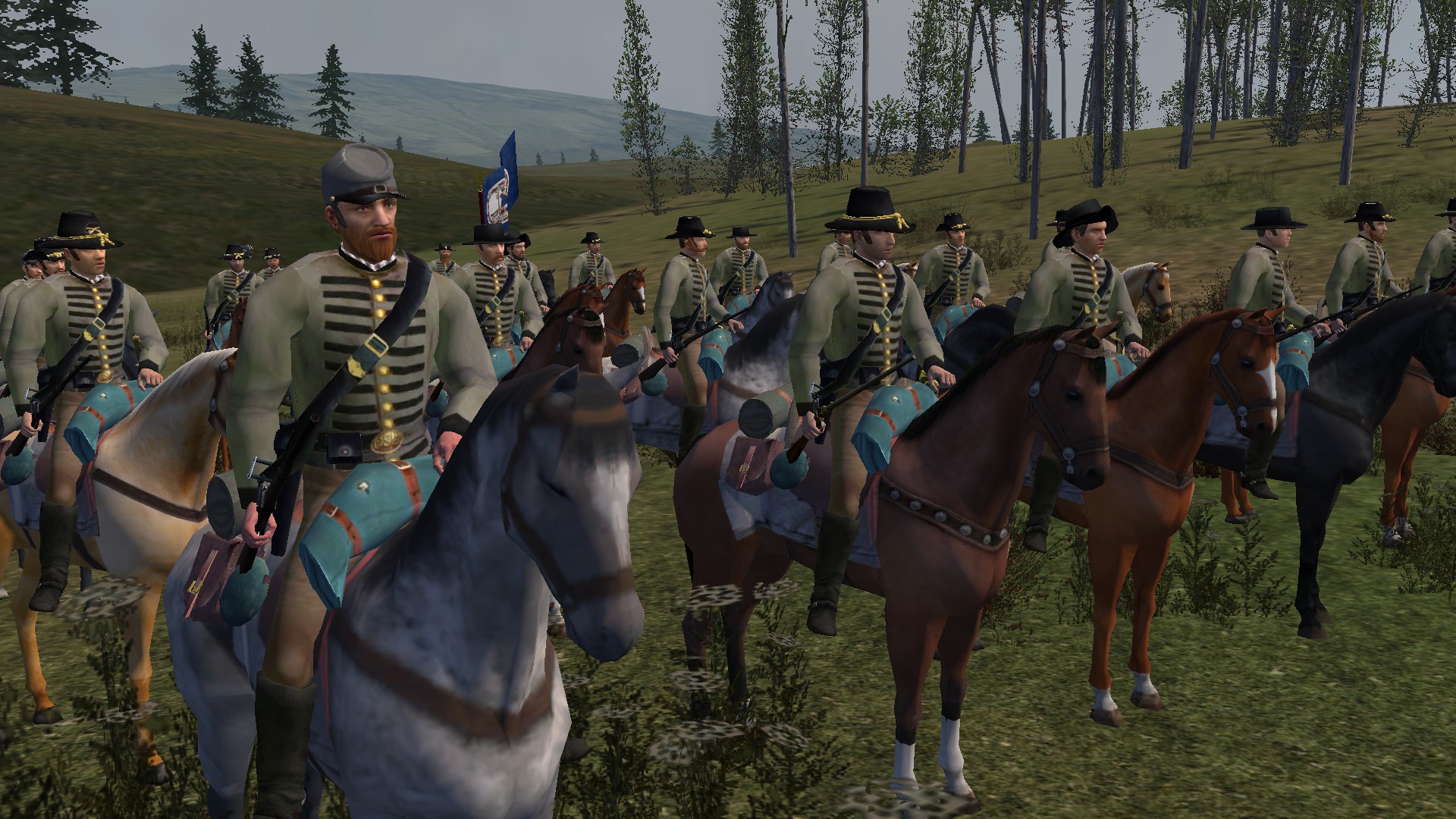
Weapons: M1859 Sharps Carbine, Pattern 1861 Enfield Musketoon, Maynard Carbine, Tarpley Carbine, Sabers
Faction: Army of Northern Virginia
Current Commander: Major General J.E.B. Stuart
Recruitment Locations: Richmond, Fredericksburg, Chancellorsville, Williamsburg, Manassas, Dinwiddie Court House, Mechanicsville
The 1st Virginia Cavalry completed its organization at Winchester, Virginia, in July 1861, under the command of Colonel James Ewell Brown (J.E.B.) Stuart at the command of General Thomas "Stonewall" Jackson. Unlike most regiments, the 1st Virginia Cavalry contained twelve companies. The men were from the counties of Amelia, Augusta, Berkeley, Clarke, Frederick, Gloucester, Jefferson, Loudoun, Rockbridge, Rockingham, and Washington. The 1st Virginia Cavalry participated in more than 200 engagements of various types throughout the American Civil War, during which it was reorganized several times.
The regiment suffered significant casualties at the First Battle of Bull Run (Manassas), leading to reorganization. During 1862, the First Virginia Cavalry participated in the Seven Days Battles and Stuart's ride around McClellan. The regiment then participated in cavalry clashes at Gainesville, Second Bull Run, Antietam, Fredericksburg, Kelly's Ford, Chancellorsville, Brandy Station, Gettysburg, Bristoe Station, the Wilderness, Todd's Tavern, Spotsylvania, Bethesda Church, and Cold Harbor.
In 1864, the 1st Virginia was involved in Jubal Early's operations in the Shenandoah Valley. Although many of the remaining soldiers either became casualties or were allowed to return to their homes by early 1865, members of the regiment did participate in the defense of Petersburg, and the Appomattox Campaign. The remains of the cavalry unit cut through the Federal lines at Appomattox, shortly before it was formally disbanded. Only one remaining man from this unit was present when General Lee formally surrendered to Grant.
34th Virginia Cavalry
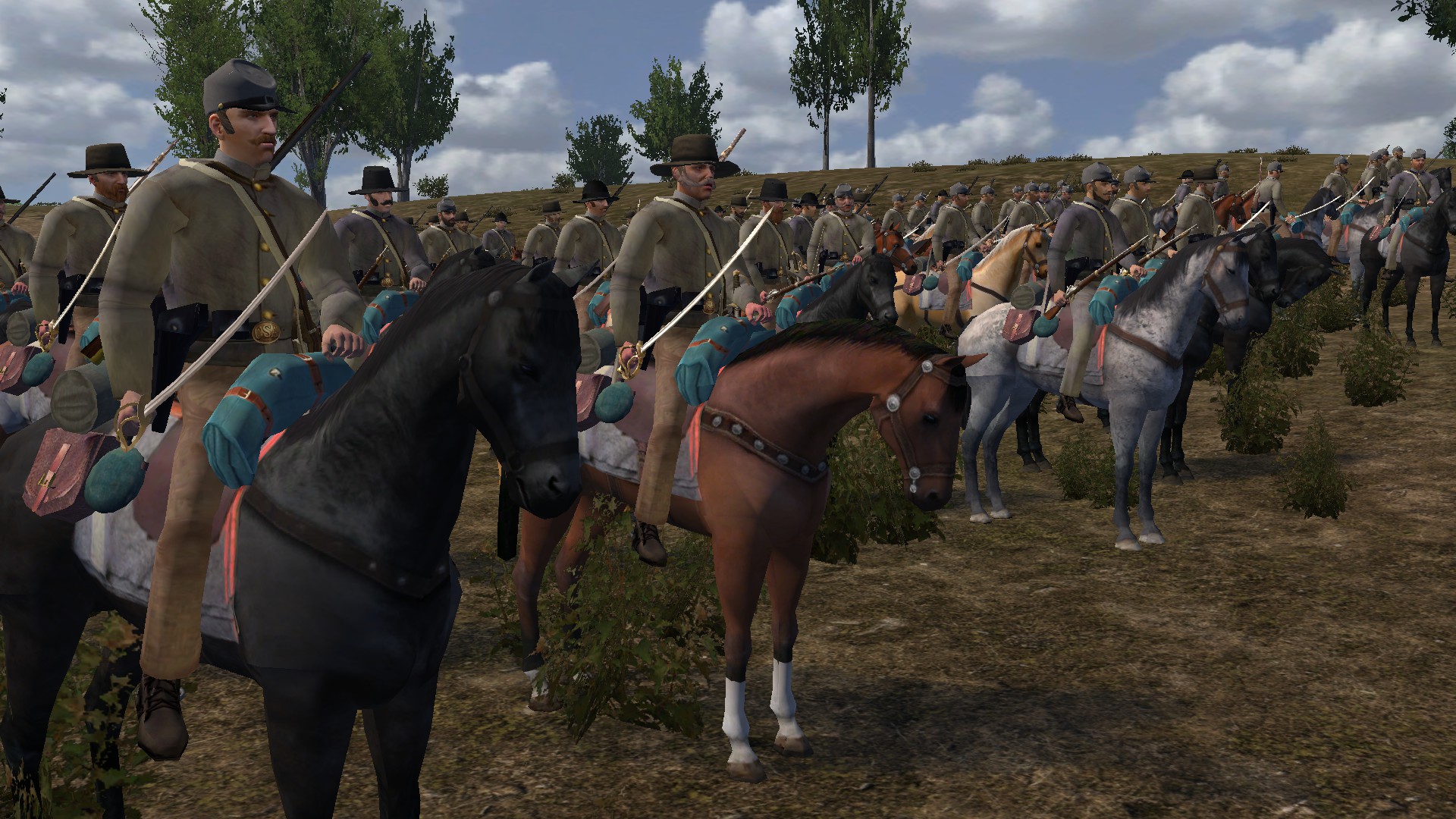
Weapons: M1841 Mississippi Rifle, Pattern 1856 Enfield "Short Rifle", Pattern 1861 Enfield Musketoon, Springfield Model 1847 Musketoon, Sabers
Faction: Army of Northern Virginia
Current Commander: Lieutenant Colonel Vincent A. "Clawhammer" Witcher
Recruitment Locations: Shepherdstown, Petersburg, Lynchburg, Norfolk, Gordonsville, Winchester, Charleston VA
The 34th Virginia Cavalry Battalion was raised in the Appalachian mountain region of southwestern Virginia and adjoining areas of what became West Virginia, as well as Tennessee, Kentucky and North Carolina. Lieutenant Colonel Vincent A. "Clawhammer" Witcher and Majors John A. McFarlane and [John] William Straton were in command. During the war it served in the cavalry brigades of Albert G. Jenkins, William E. Jones and Bradley T. Johnson. Witcher was accused of committing wartime atrocities several times, and was court-martialed, however all of the 34th Virginia Cavalry's commanding officers survived the war, and both Witcher and Straton became involved in politics.
The battalion first engaged the Federals in western Virginia. On November 10th, 1861 it raided the town of Guyandotte, where Colonel (and future Congressman) Kellian Whaley was recruiting for the Union army. It captured Whaley and several others, however Whaley managed to escape. Confederate General John B. Floyd was also concerned about allegations of plunder and robbery conducted by Witcher and his men, and ordered Witcher arrested for two murders, but General Humphrey Marshall ordered Witcher released and his rangers placed under his command. Witcher and his men became infamous for performing grisly executions via a bent sapling tied around the victims neck, which when released, would tear the head off, thereby decapitating them. This method became known as "Witcher's parole".
Although most of its activities involved raiding, the battalion fielded 172 men at the Battle of Gettysburg, before returning to western Virginia and becoming involved in operations in East Tennessee. During April, 1864, after new recruits in the new state of West Virginia added a new company, Company K, to the battalion, it contained 222 effectives. The 34th Virginia saw action at the Battle of Piedmont in Augusta County, Virginia, and fought with General Jubal Early in the Shenandoah Valley. The 34th disbanded at Lynchburg in April, 1865.

